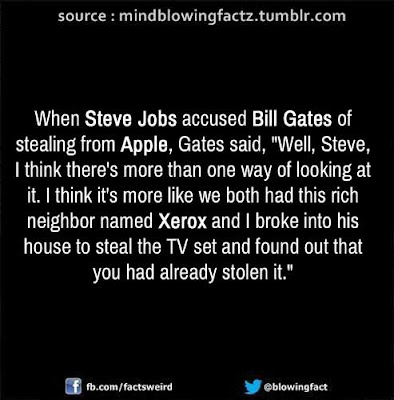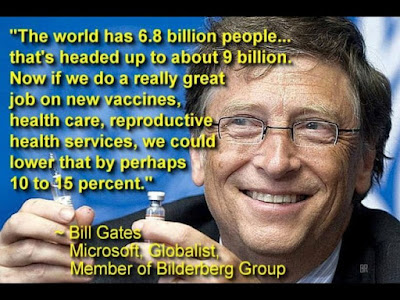1981 Gates, Kildall and MS-DOS
One of the biggest characteristics of Gates’ career is his ability
to make the most of even the tiniest opportunity, and nothing
illustrates this like the deal he made with “Big Blue” to use
MS-DOS on the new IBM PC.
The opportunity came when Gary Kildall, founder of Digital
Research which owned the then-dominant CP/M operating
system, failed to make a deal quickly enough with IBM (the
oft-repeated story that Kildall was out flying his personal plane
when IBM came calling and refused to land is, sadly, untrue).
Instead, the deal came about when Jack Sams, the lead
negotiator at IBM, asked Gates to help find an alternative.
Gates, spotting his chance, swiftly made a deal with Seattle
Computer Products to license 86-DOS to Microsoft, who in
turn reworked it, named it PC-DOS and licensed it to IBM.
1983 Gates steals the TV from
“their rich neighbour Xerox”
Microsoft started to compete with “Apple Computer” in the
early 1980s. Prior to the release of the IBM PC, Apple was one
of the largest and most important PC makers in the world, but,
by 1983, it had a strange relationship with Microsoft. It wanted
to keep Microsoft onside, to get it to develop applications for
the upcoming Macintosh, but was also worried that Microsoft
would copy the graphical user interface (GUI) for its PC-DOS.
However, Microsoft did the inevitable and announced the
first version of Windows. Steve Jobs was furious, saying “get
Gates down here immediately!” Gates calmly replied: “I think it’s
more like we both had this rich neighbor named Xerox and I
broke into his house to steal the TV set and found out that you had
already stolen it.” Apple had (legally) “borrowed” the GUI concepts from
Xerox. In the end, the Windows GUI wasn’t very Mac-like, but that didn’t stop Apple suing.
1997 Gates lends Apple $150 million
If relations between Apple and Microsoft had started declining in the 1980s, by the mid-90s they
were in need of counselling. When Steve Jobs became interim CEO following the departure of Gil
Amelio, the company was close to bankruptcy. It needed two things: money, and confidence that Apple had a future.
Jobs called his old sparring partner Gates, and put a potential deal to him: Microsoft would
invest in Apple, receiving non-voting stock. In return, the two companies would settle some
long-running legal disputes. Gates accepted. What followed was remarkable. At the summer’s Macworld Expo in Boston, Gates appeared on a giant screen to announce the deal. It was a metaphor for where the two companies now found themselves: Microsoft, the giant of the industry; Apple begging scraps. The crowd booed – Jobs told them to “forget the idea that for Apple to win, Microsoft has to lose”.
1998 Gates appears before the antitrust trial
The Microsoft antitrust cases brought by the US Department of Justice and the European Commission have probably done more to shape the recent history of the company than anything
else. Had Microsoft not had its wings clipped by the DoJ, it could have brought more of its muscle to bear on the mobile market, and made it harder for Android and iOS to gain a foothold. A turning point in the DoJ case was Gates’ appearance before the court to give his deposition. Rather than appearing in person, he gave his testimony via a video link from a Microsoft boardroom. Reports at
the time described his testimony as “evasive and unresponsive”, with Gates doing his best to pick holes in questions and effectively refuse to answer them.
2000 Gates appoints Ballmer his successor
Steve Ballmer had been at Microsoft for 20 years by the time Bill Gates decided to stand down as CEO of the company. He had long been seen as the “prince in waiting”, the obvious successor to Gates. It was only really a question of when Gates thought the time was right to step aside.
That moment came in 2000, and it’s fair to say that it proved to be one of the less successful decisions in Gates’ career. The early years of Ballmer’s leadership saw Microsoft at its peak and
making more money than it knew what to do with, but it lacked the ability to anticipate the products that would supersede Windows, continuing to bank just on Office and Windows.
2000 The Bill & Melinda Gates Foundation launched
For anyone who followed Microsoft and Gates in the 80s and 90s, the biggest surprise in his career is probably endowing most of his money to a charitable foundation. That he also created the foundation with the aim of improving global healthcare, reducing poverty and expanding educational opportunities might have been even more of a shock.
It’s a cliché to suggest that Gates’ marriage to Melinda French in 1994 brought about a change in his personality. In fact, what probably changed him more was having three children. Coupled to Gates’ ferocious intelligence and curiosity about the wider world, it’s easy to see how a wider challenge of
changing the world might be something he wanted to do.
The Gates Foundation has the largest endowment in the world, with over $42 billion in funds, and has already seen results. With the help of a vaccination drive, deaths from measles in Africa have fallen by 90%, and the foundation spends more money trying to cure the diseases affecting the world’s poorest people than any other organisation. Gates has saved countless lives, and for that we can even forgive him for Windows ME.

































No comments:
Post a Comment